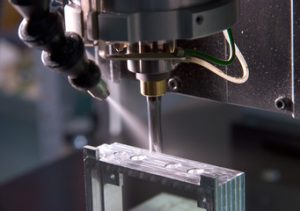Custom Plastic Injection Mold is a manufacturing process that allows businesses to produce high volumes of plastic parts at an affordable price. It is also an environmentally friendly process, reducing waste and materials. Read on Custom Plastic Injection Mold Florida for more details.

Whenever possible, designers should apply uniform wall thicknesses to molded parts. This practice ensures even cooling and improves part strength. It is also a good idea to avoid sharp corners.
When designing a custom plastic injection mold, there are many factors that must be taken into consideration. These factors include the dimensions of the product, the design of the part and the type of material that will be used in production. A thorough understanding of these factors is necessary to ensure that the end result will be a high-quality, durable product.
A good place to start is with the design of the mold itself. This process is typically done using computer-aided design (CAD), which allows designers to create a detailed, 3D model of the injection mold before starting the actual molding process. This can help to save time and money as well as avoid any errors in the manufacturing process.
Once the design of the plastic injection mold is complete, it is ready to be manufactured. This process is usually carried out by a CNC machine or electrical discharge machining (EDM). The resulting tool is then used to produce the desired plastic injection parts. There are several different types of plastic injection molds, including two-plate molds, three-plate molds and hot runner systems. Each of these has its own advantages and disadvantages, so it is important to select the right one for your project.
Injection molded parts undergo a rigorous inspection process to make sure that they are free of any defects or flaws. The inspection process is typically done by a team of experts, which includes engineers, mechanical engineers and quality assurance specialists. This is a critical step in the process because any defects or flaws can have an adverse effect on the final product.
Plastic Injection Molds are designed to withstand the stresses that occur during the manufacturing process, including shear forces, warpage and shrinkage. These stresses are caused by the molecular bonds that form between the resin layers as they are injected into the mold. It is possible to reduce these stresses by adding smooth transitions between features and using rounds or fillets in any areas that may be prone to stress.
Choosing the right plastic material is another factor that will have an impact on the final quality of your product. Some materials have specific qualities that make them better suited for certain applications, such as temperature resistance, chemical resistance or flexibility. It is also possible to combine different plastics in the injection molding process to achieve unique material properties.
Materials
A reliable custom injection molding company will have a wealth of experience working with a variety of plastic materials. They’ll be able to advise customers about material selection, whether for the best results or to reduce project costs. There’s no one-size-fits-all solution – different plastic resins have very distinct properties and behave differently under certain conditions.
When choosing a plastic injection manufacturer, look for a team with an in-house quality assurance department to ensure they’re delivering consistently high quality parts and products. The push for sustainability has also led many companies to optimize their molding operations by minimizing the amount of material used and waste generated, recycling any excess plastics, and using eco-friendly packaging and shipping options.
Most injected plastic components are made from polymer resins that can be heated and melted. They can be molded into nearly any shape imaginable, making them ideal for a range of applications. These resins are available in a wide range of hardnesses, which vary depending upon the end-use, environment, and required abrasion resistance. Acrylonitrile butadiene styrene (ABS) is a popular thermoplastic polymer that’s found in a variety of molded products, including automotive parts, kitchen appliances, commercial construction supplies, and recreational items.
Polycarbonate (PC) is another widely used polymer resin, renowned for its durability and superior impact strength. It’s often used in medical, aerospace, and military equipment. Polyamide (Nylon) is another durable thermoplastic, with excellent electrical properties and resistance to heat wear and chemicals. It’s commonly used for abrasion-resistant housings and grips.
Plastic injection molds require a substantial investment in tooling, so it’s important to work with an experienced partner who can produce them quickly and efficiently. They’ll be able to complete your project within your required time frame, allowing you to meet deadlines and deliver the best possible products to your customers.
The process of creating a plastic injection mold requires precise machining, typically with CNC machining or electric discharge machining (EDM). The quality and integrity of these metal parts will directly influence the final product’s performance and longevity. A good custom injection molding company will use a combination of these two methods to make their molds, and they’ll rigorously test them to ensure they perform as expected.
Manufacturing
Injection molding is a process where hot plastic in the liquid form is injected into a mold to create a custom plastic part. This process is used for a wide variety of products and parts, including toys, consumer and industrial goods, and medical devices. Injection molds are made using a range of processes, including computer-aided design (CAD) and electrical discharge machining (EDM).
One important consideration in the injection molding process is choosing a suitable material for the product or part. The choice of material has a significant impact on the cost and production time of the finished part. Different materials have their own properties, including flexibility and weight. A flexible plastic will be less likely to break or crack under stress, while a more stiff material may require more force to bend.
It is also necessary to consider the manufacturing process when selecting a plastic injection molding material. Different manufacturers use a variety of techniques to produce injection molds, and it is important to choose a manufacturer with a good reputation for quality and reliability. The manufacturer should be able to provide examples of previous projects and demonstrate that they have the equipment and expertise needed to produce high-quality injection molds.
Once the injection mold has been made, it is necessary to test it and make any adjustments necessary to ensure that it produces high-quality, consistent parts. Testing can include a variety of tests, including dimensional and surface finish tests. During the testing process, it is important to note any issues that arise, such as warping and sink marks.
When adding fasteners to an injection molded part, it is important to design the threads carefully. There are three ways to add fasteners to an injection molded part: by modeling a thread directly on the part, by adding a boss where the screw can be attached, or by including a threaded insert. Adding a thread directly on the part is typically not recommended, as it can increase the complexity and cost of the injection mold. However, adding a boss where the screw can be placed is generally feasible, as long as it can be located within the mold cavity and does not interfere with the function of the part.
Testing
Once the injection molding process is complete, the molded product must undergo a number of tests to ensure that it meets specific functional and aesthetic requirements. For example, the plastic must be able to support its intended weight, and it must pass inspection for thickness, uniformity, and surface finish. The testing process can include visual, touch, and laser scanning to identify any defects. The resulting test report can then be used to determine the final quality standards for the product.
While a quality inspection can be conducted manually, it is more efficient to use automation in this stage of the process. This is especially true for high-volume production runs, where the need to reduce time and cost is critical. Automated inspection can also help avoid human error that could lead to misinterpretation of results or improper handling of the molded product.
The type of material used for the injection mold is also important, as it will influence the overall quality of the resulting products. For example, some materials are more sensitive to defects, while others may be better suited for specific applications. For example, a transparent plastic is more likely to show defects such as gate blush and flow marks than a non-transparent one, which can mask these problems.
When selecting an injection molding company, consider their experience with a wide variety of materials. This will give you confidence that they can deliver high-quality products for your business. They should also be able to handle a range of post-production operations, such as surface coating and printing, to meet your unique needs.
Custom manufacturer offers precision injection molding services for small and large parts in acetal, acrylonitrile butadiene styrene (ABS), ethylene terephthalate (ETP), hyrocarbon polycarbonate (PC), low and high-density polyethylene, polypropylene, nylon, phenolic, and polyetherimide (PEI). Capable of insert and overmolding. Secondary services include bar coding, kitting, inspection, assembly, and packaging. Serves automotive, aviation, computer, telecommunications, medical, and consumer industries. ISO 9001:2008 certified.

